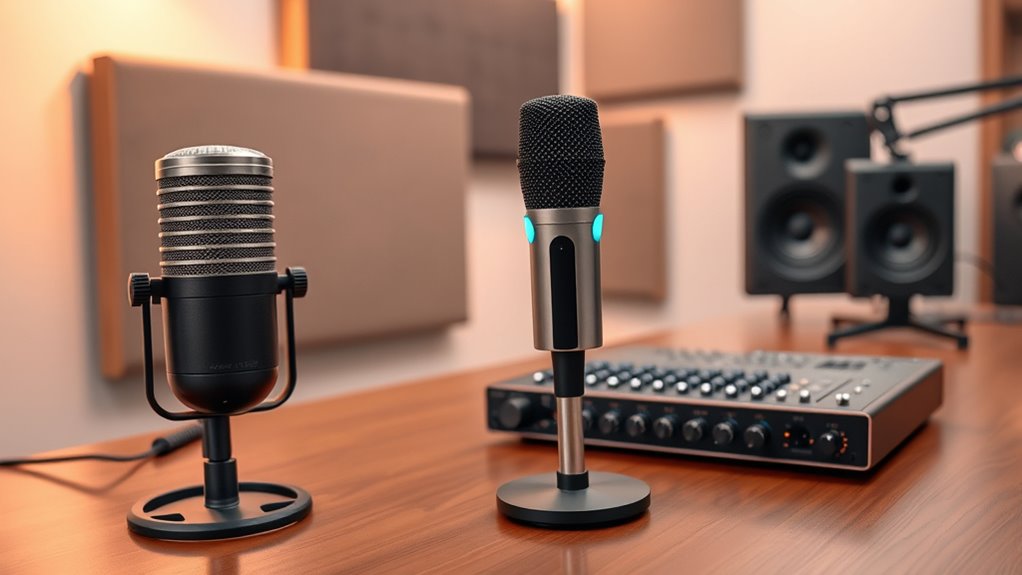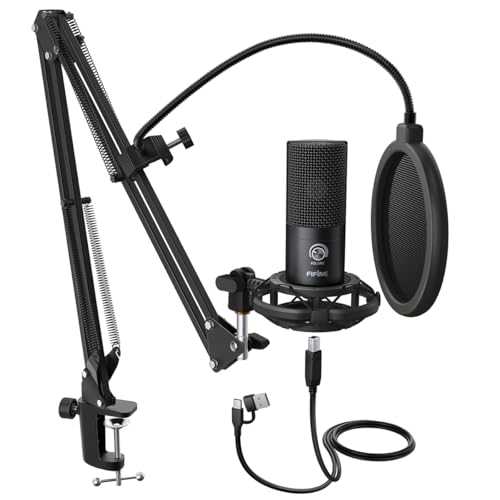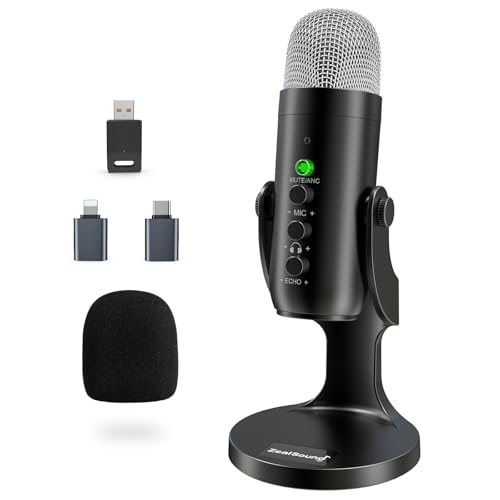If you’re looking for the best microphones for podcasts in 2025, I recommend checking out options like the Rode PodMic for broadcast-quality sound and the FIFINE K688 for versatile USB/XLR use. Wireless choices like the MAONO Lavalier are great for mobility, while dynamic mics such as the Pyle provide durability for outdoor sessions. If you want detailed insights on features and setups, exploring the list further will help you find the perfect match.
Key Takeaways
- High-quality microphones like the Rode PodMic and FIFINE Studio Condenser deliver studio-grade sound for professional podcasts.
- Versatile options support USB, XLR, and wireless connectivity for flexible setup and recording environments.
- Features such as built-in pop filters, shock mounts, and noise reduction enhance audio clarity and reduce background noise.
- Durable construction and professional designs ensure long-term reliability for podcasters in varied environments.
- Easy plug-and-play models combined with advanced features make high-quality podcasting accessible for all skill levels.
Rode PodMic Cardioid Dynamic Broadcast Microphone, Black
If you’re looking for a durable, broadcast-quality microphone that delivers professional sound without breaking the bank, the Rode PodMic is an excellent choice. Its all-metal construction feels sturdy and built to last, with a sleek black finish that looks professional. Weighing just over two pounds, it’s manageable yet solid. The internal pop filter reduces plosives, and shock mounting minimizes vibrations, ensuring clear audio. Designed mainly for podcasting and streaming, it works seamlessly with various audio interfaces, offering versatile XLR and USB-C outputs. Users rave about its rich sound, durability, and value, making it a top pick for both amateurs and pros.
Best For: content creators, podcasters, and streamers seeking a durable, professional-grade microphone with versatile connectivity.
Pros:
- Rugged all-metal construction ensures durability and a premium feel
- Broadcast-quality sound optimized for vocals and voice recordings
- Internal pop filter and shock mounting reduce plosives and vibrations
Cons:
- Heavier weight may require sturdy boom arms for optimal positioning
- Sensitivity to ambient noise necessitates proper room treatment
- Slightly complex setup for beginners, especially with multiple outputs
FIFINE K688 Podcast Microphone Kit with Boom Arm
The FIFINE K688 Podcast Microphone Kit with Boom Arm stands out as an excellent choice for beginners and budget-conscious content creators who want professional-quality sound without breaking the bank. It delivers warm, natural audio with minimal distortion, thanks to its cardioid pattern that reduces background noise. The mic supports both USB and XLR connections, making it versatile for various setups, and includes a sturdy metal boom arm and accessories for easy installation. User-friendly controls, like a tap-to-mute button and headphone monitoring, enhance usability. Priced around $70, it offers exceptional value, delivering studio-grade sound ideal for podcasting, streaming, and voice-over work.
Best For: budget-conscious beginners and content creators seeking professional-quality sound for podcasting, streaming, and voice-over work.
Pros:
- Delivers warm, natural sound with minimal distortion and ambient noise reduction.
- Versatile connectivity supporting both USB and XLR options for flexible setups.
- Includes a sturdy metal boom arm, shock mount, and user-friendly controls for easy use.
Cons:
- USB-C port quality may vary, affecting durability or connection stability.
- Additional accessories like XLR cables and interfaces are required for XLR mode, increasing setup cost.
- The boom arm, while functional, is not premium-grade and may have limited adjustability.
Pyle Dynamic Vocal Microphone with XLR Cable
The Pyle Dynamic Vocal Microphone with XLR Cable stands out as a reliable budget-friendly choice for podcasters who need clear, professional sound without breaking the bank. It features a durable all-metal zinc die-cast body, a cardioid pickup pattern that minimizes background noise, and an integrated pop filter to reduce breath sounds. With an ultra-wide frequency response up to 15 kHz and high gain before feedback, it’s versatile for both studio and live use. The package includes a 15-foot XLR cable, making setup straightforward. While some users note durability issues with the switch, overall, it offers impressive sound quality and value for aspiring podcasters.
Best For: budget-conscious podcasters and amateur performers seeking clear sound quality and reliable performance without high costs.
Pros:
- Durable all-metal zinc die-cast construction ensures robustness for live and studio use
- Cardioid pickup pattern effectively minimizes background noise and feedback
- Comes with a 15-foot professional-grade XLR cable for easy setup
Cons:
- Some users report durability issues with the ON/OFF switch over time
- Slightly limited frequency response compared to higher-end microphones
- May require careful handling to avoid damage, especially to the switch component
FIFINE Studio Condenser USB Microphone with Boom Arm Stand
Podcasters seeking a straightforward, high-quality setup will appreciate the FIFINE Studio Condenser USB Microphone with Boom Arm Stand. It offers a plug-and-play design that connects directly to your PC or laptop, eliminating the need for extra hardware or drivers. The microphone’s cardioid capsule captures clear, front-facing audio while minimizing background noise, making it perfect for home studios and voice work. The package includes a double pop filter, a sturdy steel boom arm with flexible positioning, a shock mount, and a long USB cable. Its durable build and user-friendly setup make it an excellent choice for podcasters who want professional sound without hassle.
Best For: podcasters, streamers, and home studio users seeking an easy-to-use, high-quality USB microphone with professional accessories.
Pros:
- Plug-and-play setup simplifies installation without extra hardware or drivers
- Includes comprehensive accessories like a pop filter, shock mount, and adjustable boom arm
- Durable construction and flexible positioning options enhance long-term use and sound quality
Cons:
- Not compatible with Xbox or phones, limiting device versatility
- Cardioid pattern primarily captures front-facing audio, less effective for multi-directional recording
- May require additional acoustic treatment for optimal sound in untreated environments
InnoGear Microphone Boom Arm with Cable Management
If you’re looking for a sleek, space-saving microphone arm that keeps your setup tidy, the InnoGear Microphone Boom Arm with Cable Management is a top choice. Its ultra-slim profile sits just 3.35 inches above your desk, making it perfect for minimalist or cluttered workspaces. The magnetic cable channel makes setup easy—just press to lift and snap wires into place, keeping everything organized and hidden. With full 360° rotation, 180° swivel, and 170° tilt, you get precise positioning for ideal sound quality. Made from durable alloy steel and featuring a sturdy clamp, it offers stability and longevity for your recording sessions.
Best For: content creators, streamers, and professionals seeking a sleek, space-efficient microphone arm with easy cable management.
Pros:
- Ultra-slim, modern design maximizes desk space and maintains a professional appearance
- Magnetic cable channel simplifies setup and keeps cables organized and hidden
- Fully adjustable with 360° rotation, 180° swivel, and 170° tilt for precise mic positioning
Cons:
- Supports up to 1.5 kg (3.3 lbs), which may limit use with heavier microphones
- Clamp fits desks up to 2.36 inches thick, unsuitable for thicker surfaces
- Assembly requires inserting the arm into the mount and tightening, which may be less intuitive for some users
Sony Wireless Microphone for Karaoke with 20-Hour Battery (UOULTMIC1)
For those seeking a reliable wireless microphone with extended battery life, the Sony Wireless Microphone for Karaoke with 20-Hour Battery (UOULTMIC1) stands out as an excellent choice. It includes two microphones and a receiver, compatible with all ULT POWER SOUND Series speakers featuring a microphone jack. The mic delivers bright, clear vocals with noise reduction technology that blocks wind, breath, and handling noise. Its built-in silicone damper enhances durability, while the 20-hour battery life guarantees long sessions. Plus, quick charging gives you 120 minutes of use after just 10 minutes of power, making it perfect for on-the-go singing or podcasting.
Best For: those looking for a reliable wireless microphone with long-lasting battery life for karaoke, singing, or podcasting.
Pros:
- Up to 20 hours of continuous use per charge for extended performances
- Noise reduction technology ensures bright and natural vocal clarity
- Quick charging provides 2 hours of use after just 10 minutes of power
Cons:
- Compatible only with ULT POWER SOUND Series speakers with a microphone jack
- May require additional equipment for non-compatible speakers
- Potentially limited to specific brand ecosystems, reducing versatility outside of the compatible series
Wireless Lavalier Microphone for iPhone/Android Phone/Laptop/PC
The Wireless Lavalier Microphone IUMAKEVP stands out as an excellent choice for content creators who need reliable, high-quality audio on the go. It’s compatible with iPhones, Android phones, laptops, and PCs, featuring a 360° adjustable clip and plug-and-play setup. With a wireless range of up to 100 feet and ultra-low delay, it delivers clear sound even in noisy environments thanks to noise reduction and omnidirectional mic technology. The device offers three modes—Noise Reduction, Mute, and Reverb—and provides up to 8 hours of use on a single charge. Its compact design makes it perfect for vlogs, interviews, live streams, and online meetings.
Best For: content creators, vloggers, and online professionals seeking reliable, high-quality wireless audio for mobile devices and computers.
Pros:
- Easy plug-and-play setup with broad device compatibility, including iPhone, Android, laptops, and PCs.
- Up to 100 ft wireless range with ultra-low delay and noise reduction for clear audio in noisy environments.
- Compact, portable design with 8 hours of battery life and versatile features like 360° adjustable clip and multiple modes.
Cons:
- Some Android devices or newer iPhone models may require OTG activation or encounter connectivity issues.
- Occasional difficulties with synchronization or maintaining a stable connection reported by users.
- Limited color options and potential compatibility challenges with certain hardware or software configurations.
ZealSound Wireless Microphone with Bluetooth for Podcast and Gaming
With its reliable 2.4GHz wireless technology, the ZealSound Wireless Microphone guarantees stable, lag-free audio — making it an excellent choice for podcasters and gamers who need mobility without sacrificing sound quality. It’s compatible with a wide range of devices, including iPhone, Android, PC, Mac, PS4/PS5, and tablets, with adapters included. The mic captures broadcast-quality sound with a 48kHz/24bit condenser capsule and features onboard controls like gain, echo, and mute. Its portable, sleek design includes a shock stand and accessories, providing up to 16 hours of use. Overall, it’s a versatile, user-friendly option for content creators on the go.
Best For: content creators, podcasters, streamers, and gamers seeking a portable, easy-to-use microphone with reliable wireless connectivity and decent audio quality.
Pros:
- Stable 2.4GHz wireless connection ensures lag-free, reliable audio transmission.
- Wide device compatibility with included adapters for iPhone, Android, PC, Mac, and consoles.
- Built-in controls for gain, echo, mute, and real-time monitoring facilitate professional customization.
Cons:
- Built-in echo effects are basic and may not suit professional audio production.
- Plastic construction and loud click mute button may feel less premium.
- Sensitivity can produce a thin or boxy tone compared to studio-grade microphones.
Studio Podcast Microphone with USB/XLR, Stand, Pop Filter, Headphone Jack
If you’re seeking a versatile microphone that adapts seamlessly to both professional studio setups and casual recording environments, this studio podcast microphone is an excellent choice. It features a professional dynamic design with a unidirectional core, capturing clear vocals and instruments across a wide frequency range. With both XLR and USB-C connectivity, it suits various devices and setups, while the adjustable stand and tilt offer flexible positioning. The dual-layer pop filter reduces plosives, and the built-in headphone jack provides real-time monitoring. Complete with essential accessories, this all-in-one bundle delivers studio-quality sound whether you’re recording voice-overs, streaming, gaming, or conferencing.
Best For: content creators, streamers, voice-over artists, and musicians seeking versatile, studio-quality audio recording with both professional and casual setups.
Pros:
- Offers dual connectivity options (XLR and USB-C) for maximum device compatibility.
- Includes adjustable stand and tilt for flexible positioning and comfortable use.
- Features a dual-layer pop filter and real-time headphone monitoring for clear, professional sound.
Cons:
- May be more expensive than basic microphones due to its comprehensive features.
- Requires some setup and familiarity with audio equipment for optimal use.
- May be unnecessary for users who only need simple, plug-and-play microphones.
HOTEC Dynamic Handheld Microphone with XLR Cable and ON/Off Switch
Designed for both professional and casual use, the HOTEC Dynamic Handheld Microphone stands out with its ON/OFF switch and XLR cable, making it a versatile choice for podcasters who need reliable, easy-to-operate equipment. Its cardioid pickup pattern captures clear, warm vocals while minimizing background noise and preventing feedback. Built from zinc alloy, it’s durable enough for frequent use, with a metal mesh that reduces pop noise and spring rings that protect the cable from damage. Compatible with various devices like amplifiers and mixers, it’s straightforward to set up and perfect for anything from studio recordings to outdoor events.
Best For: musicians, public speakers, and podcasters seeking a durable, easy-to-use microphone with clear sound and reliable performance for both casual and professional settings.
Pros:
- High-quality cardioid pickup pattern minimizes background noise and feedback for clear vocals
- Durable zinc alloy construction with protective metal mesh and spring rings for long-lasting use
- Compatible with a wide range of devices including amplifiers, mixers, and KTV systems with plug-and-play operation
Cons:
- May require additional accessories for certain setups or professional studio use
- Wired connection limits mobility compared to wireless microphones
- Slightly heavier due to robust build, which might be less ideal for extended handheld use
ZealSound Gaming Microphone Kit with Boom Arm and Monitor
The ZealSound Gaming Microphone Kit with Boom Arm and Monitor stands out as a top choice for streamers and content creators seeking professional-quality audio combined with versatile setup options. Its plug-and-play USB design works seamlessly with PS4, Windows, Mac, iPhone, Android, and more, no drivers needed. The microphone features intelligent noise reduction, a supercardioid pattern, and handles high SPLs, ensuring clear, natural vocals. The durable metal boom arm offers 360° rotation and flexible positioning, while onboard controls for mic gain, echo, and monitoring give precise audio management. With a complete bundle—including cables, adapters, and accessories—it’s a thorough, ready-to-use solution for high-quality streaming and recording.
Best For: streamers, content creators, and gamers seeking professional-quality audio with versatile, easy-to-setup equipment.
Pros:
- Compatible with a wide range of devices including PS4/5, Windows, Mac, iPhone, Android, and more, with no drivers needed.
- Equipped with intelligent noise reduction and a supercardioid pattern for clear, natural vocals and minimized background noise.
- Includes a complete bundle with adjustable arm, cables, adapters, and onboard controls for precise audio management.
Cons:
- The setup may be bulky due to the included boom arm and accessories, requiring sufficient desk space.
- Some users might find the onboard controls complex initially, needing a learning curve for optimal use.
- The supercardioid pattern, while excellent for noise reduction, may require precise positioning to avoid audio drop-off.
InnoGear Microphone Stand, 2 Pack Tripod Boom Arm with Carrying Bag
For podcasters seeking a reliable and versatile microphone stand, the InnoGear Microphone Stand, 2 Pack Tripod Boom Arm with Carrying Bag offers an excellent solution. It features adjustable height from 28.1 to 89.8 inches and a flexible boom arm that rotates 360° horizontally and moves up to 180° vertically. Made of durable alloy steel, it provides stability and can support heavier microphones like the Shure SM7B. The stand disassembles easily into parts for transport and storage in the included carrying bag. Customers praise its solid build, stability, and affordability, making it a versatile choice for home studios, streaming, and podcasting setups.
Best For: podcasters, streamers, and home studio users seeking a stable, adjustable, and portable microphone stand for various recording needs.
Pros:
- Durable alloy steel construction offers stability and supports heavier microphones like the Shure SM7B.
- Adjustable height (28.1 to 89.8 inches) and flexible boom arm with 360° horizontal rotation and 180° vertical movement for versatile positioning.
- Easy disassembly and compact carrying bag make transport and storage convenient.
Cons:
- Some users report difficulty opening the bottom clamp or loosening of nut and bolt clamps over time.
- Clamp strength may be insufficient for very heavy or active use in certain environments.
- Assembly can be challenging for some, especially when adjusting parts for the first time.
ZealSound XLR/USB Microphone for Gaming and Streaming
If you’re looking for a versatile microphone that seamlessly adapts to various devices and setups, the ZealSound XLR/USB Microphone is an excellent choice for gaming, streaming, and podcasting. It supports USB connection for easy use with PC, MacBook, iPhone, Type-C phones, iPad, and Android tablets, plus XLR for professional sound cards or mixers. Its dynamic design delivers clear, natural sound with noise rejection and a focused cardioid pattern. The customizable RGB lighting adds style, while intuitive controls like volume knobs and a tap-to-mute button ensure smooth operation. Packed with accessories, this all-in-one bundle makes high-quality content creation simple and efficient.
Best For: content creators, streamers, and gamers seeking a versatile, high-quality microphone compatible with multiple devices and setups.
Pros:
- Supports both USB and XLR connections for flexible use across various platforms and equipment
- Customizable RGB lighting and intuitive controls enhance user experience and aesthetics
- Includes a comprehensive bundle of accessories, making it a ready-to-use professional setup
Cons:
- May be more expensive compared to basic microphones without advanced features
- The size and additional features could be overwhelming for casual users seeking simplicity
- Requires setup and adjustment, which might be challenging for beginners unfamiliar with audio equipment
Rockville GN20 Microphone Stand with Clamp
When setting up your podcast recording space, the Rockville GN20 Microphone Stand with Clamp stands out with its sturdy steel construction and flexible 20-inch gooseneck, making it ideal for podcasters who need precise microphone positioning without sacrificing durability or stability. Its stiff design holds shape during recording or live sessions, while the adjustable rubberized clamp attaches securely to surfaces up to 1.5 inches thick without scratching. Compatible with most microphones thanks to its versatile threading options, this stand is ready to use out of the box and works seamlessly with accessories like shock mounts and smartphone holders. It’s a reliable choice for any professional or hobbyist podcaster.
Best For: podcasters, DJs, and recording professionals seeking a durable, flexible, and stable microphone stand for studio or live use.
Pros:
- Sturdy steel construction ensures long-lasting durability
- Flexible 20-inch gooseneck allows precise and adjustable microphone positioning
- Compatible with most microphones and accessories, ready to use out of the box
Cons:
- Clamp attachment may not fit surfaces thicker than 1.5 inches
- Limited to 20-inch reach, which may be short for some setups
- Does not include additional accessories like shock mounts or smartphone holders
MAONO Wireless Lavalier Microphone for iPhone/Android/Camera/PC
The MAONO Wireless Lavalier Microphone stands out as an ideal choice for creators who need professional-quality audio on the go. Weighing just 9 grams, it’s lightweight, durable, and easy to attach with magnetic clips. The device offers up to 30 hours of total use thanks to its portable charging case, and supports charging during recording. Compatible with iPhone, Android, cameras, and PCs, it delivers studio-grade sound with a 48kHz/24-bit format, low noise, and interference-resistant digital transmission. Its customizable noise cancellation and voice filters guarantee clear, professional audio even in noisy environments, making it perfect for interviews, vlogs, and live streaming.
Best For: content creators, vloggers, filmmakers, and podcasters seeking professional-quality wireless audio on the go across multiple devices.
Pros:
- Lightweight and durable design with magnetic clips for easy attachment
- Up to 30 hours of total operation with charging case and support for charging during recording
- Studio-grade sound quality with customizable noise cancellation and voice filters
Cons:
- Limited Lightning connector support, only USB-C available
- Occasional magnet detachment issues with clips
- Slightly heavier than some competitors at approximately 10.6 ounces
Factors to Consider When Choosing Microphones for Podcasters 2025

When choosing a microphone for podcasting in 2025, I consider factors like the type and pattern to match my recording style, along with compatibility and connectivity options for seamless setup. Sound quality and clarity are vital, but I also look at build durability and design to guarantee longevity. Finally, I balance my budget with the value each microphone offers to find the best fit for my needs.
Microphone Type and Pattern
Choosing the right microphone type and pattern is essential for achieving clear, focused sound in your podcast. Cardioid microphones are popular because they pick up sound primarily from the front, which helps minimize background noise. Dynamic microphones are durable and excel at rejecting ambient noise, making them perfect for noisy environments. Condenser microphones offer higher sensitivity and a broader frequency response, ideal for studio-quality recordings, but they require a sound-treated space. Omnidirectional microphones capture sound from all directions, suitable for group recordings but more prone to background noise. The microphone pattern notably impacts how well your voice is isolated and how much environmental sound is picked up. Selecting the appropriate type and pattern depends on your recording environment and specific podcasting needs.
Compatibility and Connectivity Options
Selecting the right microphone involves more than just sound quality; compatibility and connectivity options play a key role in ensuring your setup works smoothly. First, check that your microphone supports your device’s connection type—USB, XLR, Lightning, or USB-C—for seamless integration. Determine if it offers plug-and-play functionality or if you’ll need additional interfaces, drivers, or adapters. Wireless capabilities like Bluetooth or 2.4GHz transmission can provide a cable-free setup, but make sure they suit your environment. Also, verify compatibility with your operating system—Windows, Mac OS, iOS, or Android—to avoid connectivity issues. Ultimately, consider whether the connection supports real-time monitoring and integrates easily with your existing audio gear, ensuring a smooth recording experience.
Sound Quality and Clarity
Sound quality and clarity are crucial for producing professional-sounding podcasts, and the key factors to contemplate include frequency response, signal-to-noise ratio, and polar pattern. A wide frequency response, like 20 Hz to 20 kHz, ensures the microphone captures the full vocal range accurately. A high signal-to-noise ratio (above 70 dB) minimizes background noise, resulting in cleaner audio. Cardioid polar patterns are ideal because they focus on your voice and reduce ambient sounds, enhancing clarity. Microphones with low self-noise, such as -70 dB, prevent internal hiss from interfering with your recordings. Proper gain settings and positioning are indispensable to maintain natural sound and avoid distortion. Prioritizing these factors helps achieve crisp, professional-quality sound for your podcast.
Build Durability and Design
When evaluating microphones for podcasting, durability and design are essential to guarantee your equipment withstands regular use and transport. Microphones with all-metal construction, like zinc alloy or steel, tend to be more resistant to damage and wear. A sturdy yoke or mounting bracket helps prevent vibrations and accidental drops, extending the mic’s lifespan. Built-in shock mounts and internal shock absorption features protect against external shocks and handling noise, ensuring consistent sound quality. Compact, well-designed mics with minimal protruding parts are less prone to breakage and easier to carry safely. Additionally, reinforced connectors and cables that resist bending, pulling, and wear contribute to long-term reliability. Prioritizing these design features guarantees your microphone remains durable and functional, even with frequent use.
Budget and Value Considerations
Balancing features and affordability is essential when choosing a microphone for podcasting in 2025. I recommend selecting models that offer the best value for your budget, balancing performance with cost. High-quality microphones with all-metal construction and professional sound tend to be more expensive but are a better long-term investment. If you’re on a tight budget, USB microphones can still deliver excellent sound quality, though they may lack advanced features found in pricier options. Considering versatile connectivity options like XLR and USB can future-proof your setup and provide greater flexibility. Additionally, comparing the cost-to-performance ratio—especially when including accessories like boom arms, pop filters, or shock mounts—helps maximize value without unnecessary spending. Prioritizing these factors ensures you get studio-quality sound without overspending.
Frequently Asked Questions
What Is the Best Microphone Type for Podcasting in 2025?
The best microphone type for podcasting in 2025 is a dynamic microphone. I prefer it because it effectively minimizes background noise, making my recordings clearer and more professional. Dynamic mics are durable and great for various environments, whether I’m recording in a busy studio or on the go. They’re reliable, offer excellent sound quality, and are typically more affordable, making them my top choice for consistent, studio-quality podcasts.
How Do I Choose Between USB and XLR Microphones?
When choosing between USB and XLR microphones, I consider my setup and future needs. USB mics are plug-and-play, great for beginners or quick setups, and work directly with computers. XLR mics deliver higher audio quality and flexibility but require an audio interface and some technical know-how. If you’re starting out, USB is easier. But if you want professional sound and room to grow, XLR is the way to go.
What Features Are Essential for Studio-Quality Podcast Sound?
Did you know 85% of listeners say sound quality influences their podcast loyalty? To get studio-quality sound, I focus on a microphone with a wide frequency response, so my voice sounds natural. I also look for features like a cardioid polar pattern to minimize background noise, and a sturdy build for durability. A built-in pop filter helps reduce plosive sounds, ensuring my recordings are clear and professional.
Are Wireless Microphones Reliable for Professional Podcasting?
Wireless microphones can be reliable for professional podcasting if you choose the right model. I’ve found that quality wireless mics with solid encryption, stable connections, and good battery life work well, especially in controlled environments. However, they might occasionally face interference or dropouts. For ultimate reliability, I still recommend wired mics for critical recordings, but modern wireless options can definitely handle professional needs when selected carefully.
How Important Is Microphone Accessories Like Boom Arms and Pop Filters?
Think of your microphone setup as a stage for a performance. Accessories like boom arms and pop filters are the stagehands that keep everything in place and clear. They’re vital because they improve sound quality, reduce noise, and make recording more comfortable. Without them, your voice might sound cluttered or muffled. So, investing in these accessories guarantees your podcast sounds professional and polished, just like a well-orchestrated show.
Conclusion
Choosing the right microphone can be like finding the perfect piece of a puzzle—it completes your sound and brings your voice to life. With these top picks, you’ll be well on your way to creating a polished, professional podcast that feels as smooth as a gentle breeze. Remember, the best mic is the one that feels right for you, helping your ideas flow effortlessly and enthralling your audience with clarity and warmth.

























